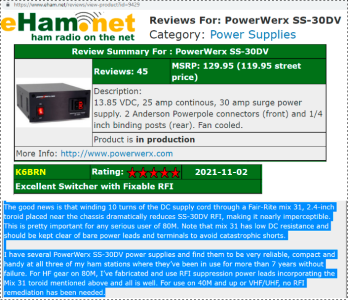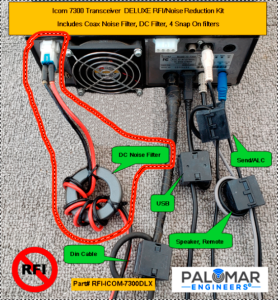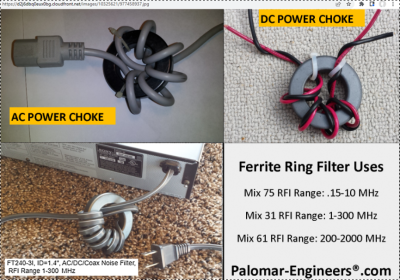:::
- En eham_net . Reseñas de: PowerWerx SS-30DV
hay una persona que recomienda "enrollar 10 vueltas del cable de alimentación de CC a través de un toroide Fair-Rite mix 31 de 2,4 pulgadas colocado cerca del chasis reduce drásticamente la RFI del SS-30DV, haciéndola casi imperceptible. Esto es bastante importante para cualquier usuario serio de 80M. Tenga en cuenta que la mezcla 31 tiene una baja resistencia de CC y debe mantenerse libre de terminales y cables de alimentación desnudos para evitar cortocircuitos catastróficos"
:::
·
- La traduccion no es muy correcta por lo que os pongo el texto original de eham_net, de la reseña de K6BRN en PowerWerx SS-30DV
The PowerWerx SS-30DV switching power supply runs about $110, is the size of a paperback book (very small), has dual Powerpole connectors and ¼ inch binding posts built in, weighs about 3 pounds, easily support a 21A/14V continuous load with periodic excursions to its CASE MARKED maximum 25A/14V rating where it gets pretty hot, despite it’s pretty quiet built-in cooling fan.
This compact, light, reliable and very handy power supply is easily adequate for a single 100W HF transceiver, even running FT8, but with significantly less headroom than the comparatively massive and large (linear) 25 pound Astron RS-35A (at about twice the price, new), the apparent, de-facto reference standard in HF radio power supplies.
Displayed on a 200 MHz BW oscilloscope, SS-30DV switching noise is a relatively low 100 mV p-p on the DC output with a 21 Amp load (typical HF transceiver TX current). Resulting RFI is broadly distributed across lower HF bands as shown on a 3GHz spectrum analyzer. In a simple HF receiver listening test (with stub antenna), periodic RFI spurs on 160M are present at low amplitude but wander slowly across the band – they are not fixed and you cannot avoid them. Wandering RFI spurs on 80M are quite loud and annoying but becomes imperceptible at 40M and above. Note that some switching power supplies, like the MegaWatt S-400-12, appear to use a ceramic resonator as a switching frequency reference, with fixes RFI spurs in place and prevents them from wandering, which reduces the “annoyance factor” a bit.
The good news is that winding 10 turns of the DC supply cord through a Fair-Rite mix 31, 2.4-inch toroid placed near the chassis dramatically reduces SS-30DV RFI, making it nearly imperceptible. This is pretty important for any serious user of 80M. Note that mix 31 has low DC resistance and should be kept clear of bare power leads and terminals to avoid catastrophic shorts.
I have several PowerWerx SS-30DV power supplies and find them to be very reliable, compact and handy at all three of my ham stations where they’ve been in use for more than 7 years without failure. For HF gear on 80M, I’ve fabricated and use RFI suppression power leads incorporating the Mix 31 toroid mentioned above and all is well. For use on 40M and up or VHF/UHF, no RFI remediation has been needed.
Two of my stations use the PowerWerx switchers while the third uses Astron linear supplies, which generate no RFI at all and won’t, unless they’re broken and the feedback control loop is oscillating or a component or connector is failing.
Both the Powerwerx SS-30DV and Astron RS-35A power supplies are excellent products – but there are tradeoffs: Much smaller size/weight/cost for the Powerwerx SS-30DV, but requires some RFI suppression steps on HF/80M, vs. zero RFI and significantly higher capacity from the much more massive and costly Astron RS-35A.
Every amateur radio switching power supply I’ve tested has generated some RFI, but generally gives back in price and size/weight/power. As SS-30DV RFI is easily remediated and the product is quite solid, I give it 5 stars in the switching supply class. I’d give the Astron linear supplies the same rating in its own linear supply class for being noise-free, reliable and well supported. They are easily repaired when a capacitor or pass transistor finally goes after 30 years.
Which one is best for your application? That’s up to you. It’s good to have choices!
Brian – K6BRN
:::
:::
. Por lo que creo, que se refiere algo similar a la imagen "DC noise fiter"
·
· imagen "DC power choke" con ferrita F240-31, Mode RFI/Noise
·
·
73 Carlos EC1T
Carlos EC1T
Ex. EA1DVY
Soria in81
QDURE - https://qsl.ure.es
Imprime y confirma tus QSL en tan solo tres click.
Nunca fue tan fácil y cómodo
el confirmar tus contactos.
TIENDA ONLINE URE
Publicaciones, mapas, polos, camisetas, gorras, tazas, forros polares y mucho más...
WEBCLUSTER EA4URE
Conoce el nuevo WebCluster de URE, ahora con nuevos filtros e información y compatible con GDURE







